Performance Degradation of Ground Source Heat Pump Systems Under Ground Temperature Disturbance: A TRNSYS-Based Simulation Study
Abstract
1. Introduction
- (1)
- A multi-scale response framework is developed to characterize both long-term GT–COP coupling and short-cycle system dynamics;
- (2)
- A quantitative degradation coefficient is established, indicating that each 1 °C increase in GT results in an average COP decline of approximately 0.038;
- (3)
- ΔT is identified as a mediating variable in the Load–GT–ΔT–COP pathway. This relationship is validated through analysis of long-term performance trends and short-cycle system responses, revealing that thermal boundary shifts progressively diminish system efficiency.
2. Materials and Methods
2.1. Building Description and Load Simulation
2.2. Model Construction and Configuration
- Heating: evaporator inlet at 10 °C, condenser supply/return at 40/45 °C;
- Cooling: condenser inlet at 25 °C, evaporator supply/return at 12/7 °C;
- Water specific heat: 4.19 kJ/(kg·K).
2.3. Theoretical Framework of Ground–COP Coupling
- (1)
- Transient Ground Thermal Response
- : initial undisturbed ground temperature (°C);
- : heat input per unit borehole length (W/m);
- : soil thermal conductivity (W/m·K);
- : thermal diffusivity of soil (m2/s);
- : exponential integral function.
- (2)
- Heat Transfer and ΔT–COP Linkage
- : useful heat transfer (kW);
- : electrical input to the compressor (kW).
- : overall heat transfer coefficient (W/m2·K);
- : effective heat exchange area (m2);
- : temperature difference between fluid inlet and outlet on the ground side.
- (3)
- Multi-Level Response Pathway: GT–ΔT–COP
- : condenser temperature (K);
- : evaporator temperature (K).
2.4. Model Validation
- Annual cooling-to-heating load ratio: simulated 2.43 vs. 2.51 (error: 3.19%);
- Ground temperature rise: 1.77 K vs. 1.90 K (error: 6.84%);
- Maximum inlet water temperature: 33.46 °C vs. 35.00 °C (error: 4.40%);
- Annual average COP: 3.06 vs. 3.09 (error: 0.97%).
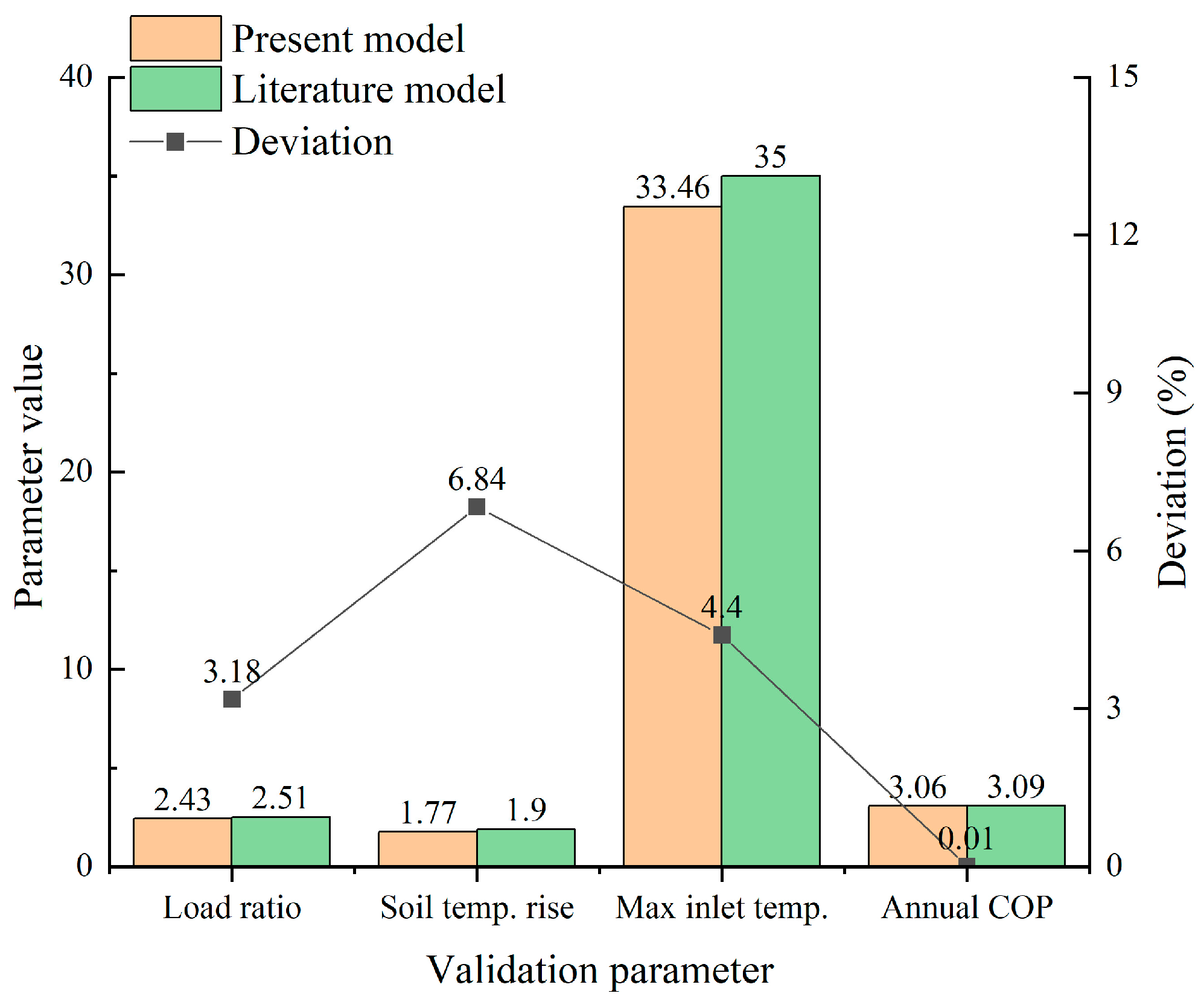
3. Results and Discussion
3.1. Annual-Scale Coupling Between Ground Temperature and COP

3.2. Short-Term Operational Comparison Across Typical Years
3.3. Coupling Mechanism and Causal Pathway Between Ground Temperature, Load, and COP
4. Conclusions
Author Contributions
Funding
Data Availability Statement
Acknowledgments
Conflicts of Interest
Abbreviations
| GT | Ground temperature |
| GSHP | Ground source heat pump |
| COP | Coefficient of performance |
| ΔT | Heat exchange temperature difference on the ground source side |
| HSCW | Hot summer and cold winter |
| TMY | Typical Meteorological Year |
References
- Hepbasli, A.; Kalinci, Y. A Review of Heat Pump Water Heating Systems. Renew. Sustain. Energy Rev. 2009, 13, 1211–1229. [Google Scholar] [CrossRef]
- Kavanaugh, S.P.; Rafferty, K. Ground-Source Heat Pumps: Design of Geothermal Systems for Commercial and Institutional Buildings; ASHRAE: Atlanta, GA, USA, 1997. [Google Scholar]
- Lund, J.W.; Toth, A.N. Direct Utilization of Geothermal Energy 2020 Worldwide Review. Geothermics 2021, 90, 101915. [Google Scholar] [CrossRef]
- Christodoulides, P.; Christou, C.; Aresti, L.; Stylianou, I.I.; Florides, G.A. Operation Performance of a Ground Source Heat Pump System in the Mediterranean Climate Zone: First Results. Energy Effic. 2025, 18, 21. [Google Scholar] [CrossRef]
- Chanchayanon, T.; Chaiprakaikeow, S.; Jotisankasa, A.; Inazumi, S. Enhancing Smart City Energy Efficiency with Ground Source Heat Pump Systems and Integrated Energy Piles. Smart Cities 2024, 7, 3547–3586. [Google Scholar] [CrossRef]
- Zhao, Z.; Shen, R.; Feng, W.; Zhang, Y.; Zhang, Y. Soil Thermal Balance Analysis for a Ground Source Heat Pump System in a Hot-Summer and Cold-Winter Region. Energies 2018, 11, 1206. [Google Scholar] [CrossRef]
- Choi, W.; Ooka, R.; Nam, Y. Impact of Long-Term Operation of Ground-Source Heat Pump on Subsurface Thermal State in Urban Areas. Sustain. Cities Soc. 2018, 38, 429–439. [Google Scholar] [CrossRef]
- Kim, S.K.; Lee, Y. Evaluation of Ground Temperature Changes by the Operation of the Geothermal Heat Pump System and Climate Change in Korea. Water 2020, 12, 2931. [Google Scholar] [CrossRef]
- Chiasson, A.D.; Rees, S.J.; Spitler, J.D. A Preliminary Assessment of the Effects of Groundwater Flow on Closed-Loop Ground Source Heat Pump Systems. ASHRAE Trans. 2000, 106, 380–393. [Google Scholar]
- Xu, L.; Pu, L.; Zhang, S.; Li, Y. Hybrid Ground Source Heat Pump System for Overcoming Soil Thermal Imbalance: A Review. Sustain. Energy Technol. Assess. 2021, 44, 101098. [Google Scholar] [CrossRef]
- Sagia, Z.; Rakopoulos, C.; Kakaras, E. Cooling Dominated Hybrid Ground Source Heat Pump System Application. Appl. Energy 2012, 94, 41–47. [Google Scholar] [CrossRef]
- Salhein, K.; Kobus, C.; Zohdy, M. Control of Heat Transfer in a Vertical Ground Heat Exchanger for a Geothermal Heat Pump System. Energies 2022, 15, 5300. [Google Scholar] [CrossRef]
- Cho, Y.H.; Shin, J.H. A Variable Water Flow Rate Control Method of Hybrid Geothermal Heat Pump Systems. Renew. Energy 2024, 214, 120456. [Google Scholar] [CrossRef]
- Yuan, T.; Zhuang, Z.; Yu, M. Study on Long-Term Operation Characteristics of the Medium-Deep Ground Source Heat Pump System with Solar Heat Storage. Appl. Therm. Eng. 2024, 225, 120266. [Google Scholar] [CrossRef]
- Gamage, K.; Chung, J.; Pathirana, W.P.M.R.; Harbor, D.J.; Jo, W.; Jeem, A.; Chung, J. A Cost-Effective 3D Finite Element Model for Predicting Transient Heat Transfer in U-Tube Ground Heat Exchangers. In Proceedings of the 2024 Global Energy Conference (GEC), Batman, Turkey, 4–6 December 2024; IEEE: New York, NY, USA. [Google Scholar] [CrossRef]
- Wang, P.; Wang, Y.; Gao, W.; Xu, T.; Wei, X.; Shi, C.; Qi, Z.; Bai, L. Uncovering the Efficiency and Performance of Ground-Source Heat Pumps in Cold Regions: A Case Study of a Public Building in Northern China. Buildings 2023, 13, 1564. [Google Scholar] [CrossRef]
- Gebhardt, H.; Mohammadi, H.S.; Ebert, A. High-Resolution Monitoring and Simulation of the Temperatures in a Borehole Heat Exchanger Field over Multiple Years. In Proceedings of the International Ground Source Heat Pump Association Conference, Montreal, QC, Canada, 28–30 May 2024. [Google Scholar] [CrossRef]
- Mohammadzadeh Bina, S.; Fujii, H.; Kosukegawa, H.; Inagaki, F. A Predictive Model of Long-Term Performance Assessment of Ground Source Heat Pump (GSHP) Systems in Japanese Regions. Geothermics 2024, 119, 102955. [Google Scholar] [CrossRef]
- Lan, T.; Hu, R.; Tang, Q.; Han, M.; Wu, S.; Liu, G. A Multivariate Nonlinear Regression Prediction Model for the Performance of Cooling Tower Assisted Ground Source Heat Pump System. Energy Convers. Manag. 2025, 325, 119333. [Google Scholar] [CrossRef]
- Xie, Y.; Hu, P.; Peng, D.; Zhu, N.; Lei, F. Development of a Group Control Strategy Based on Multi-Step Load Forecasting and Its Application in Hybrid Ground Source Heat Pump. Energy 2023, 273, 127196. [Google Scholar] [CrossRef]
- GB 50189-2015; Design Standard for Energy Efficiency of Public Buildings. China Architecture & Building Press: Beijing, China, 2015.
- Hellström, G. Ground Heat Storage: Thermal Analyses of Duct Storage Systems. Ph.D. Thesis, Department of Mathematical Physics, University of Lund, Lund, Sweden, 24 May 1991. [Google Scholar]
- Liu, Z.; Li, Y.; Xu, W.; Yin, H.; Gao, J.; Jin, G.; Lun, L.; Jin, G. Performance and feasibility study of hybrid ground source heat pump system assisted with cooling tower for one office building based on one Shanghai case. Energy 2019, 173, 28–37. [Google Scholar] [CrossRef]
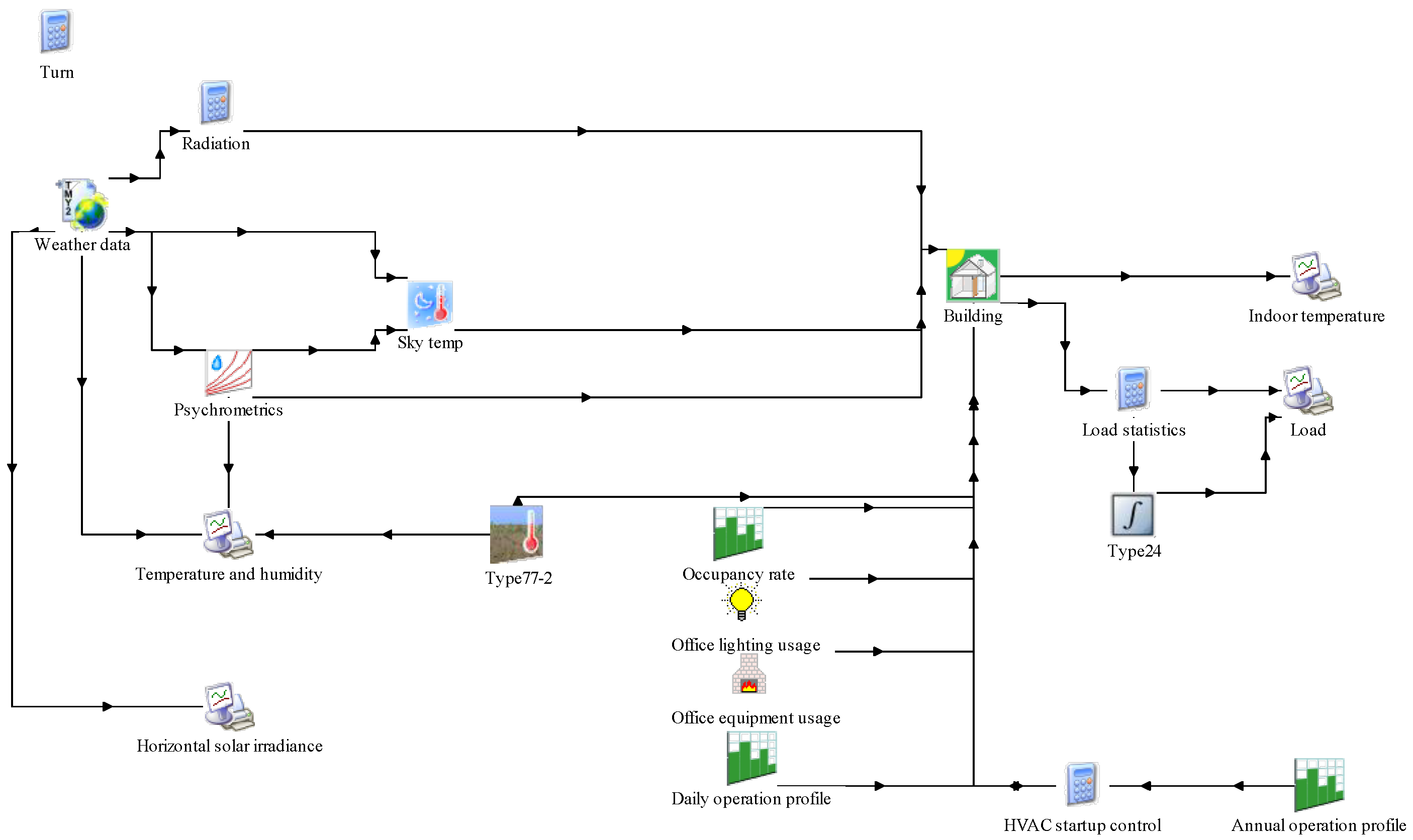
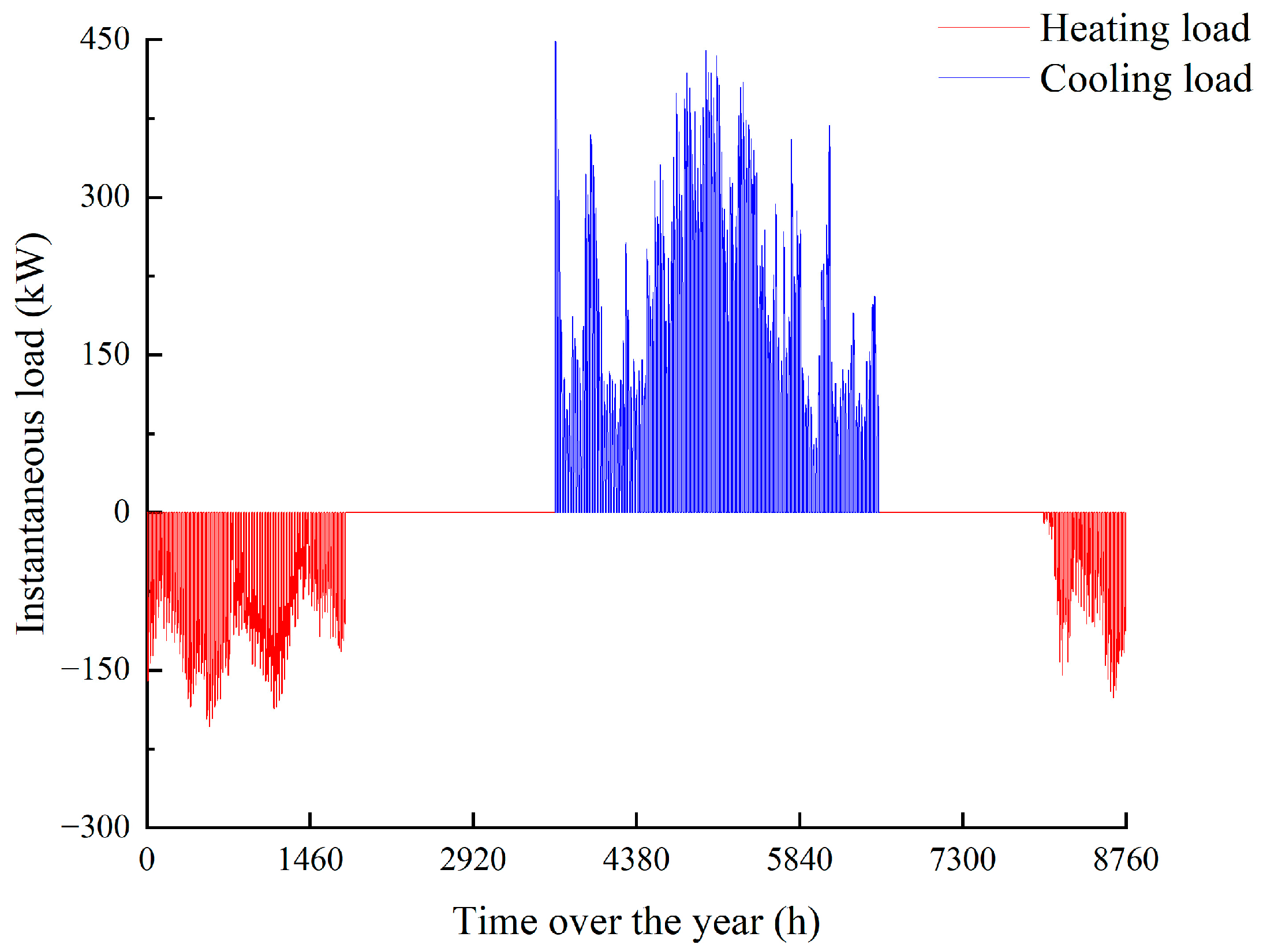

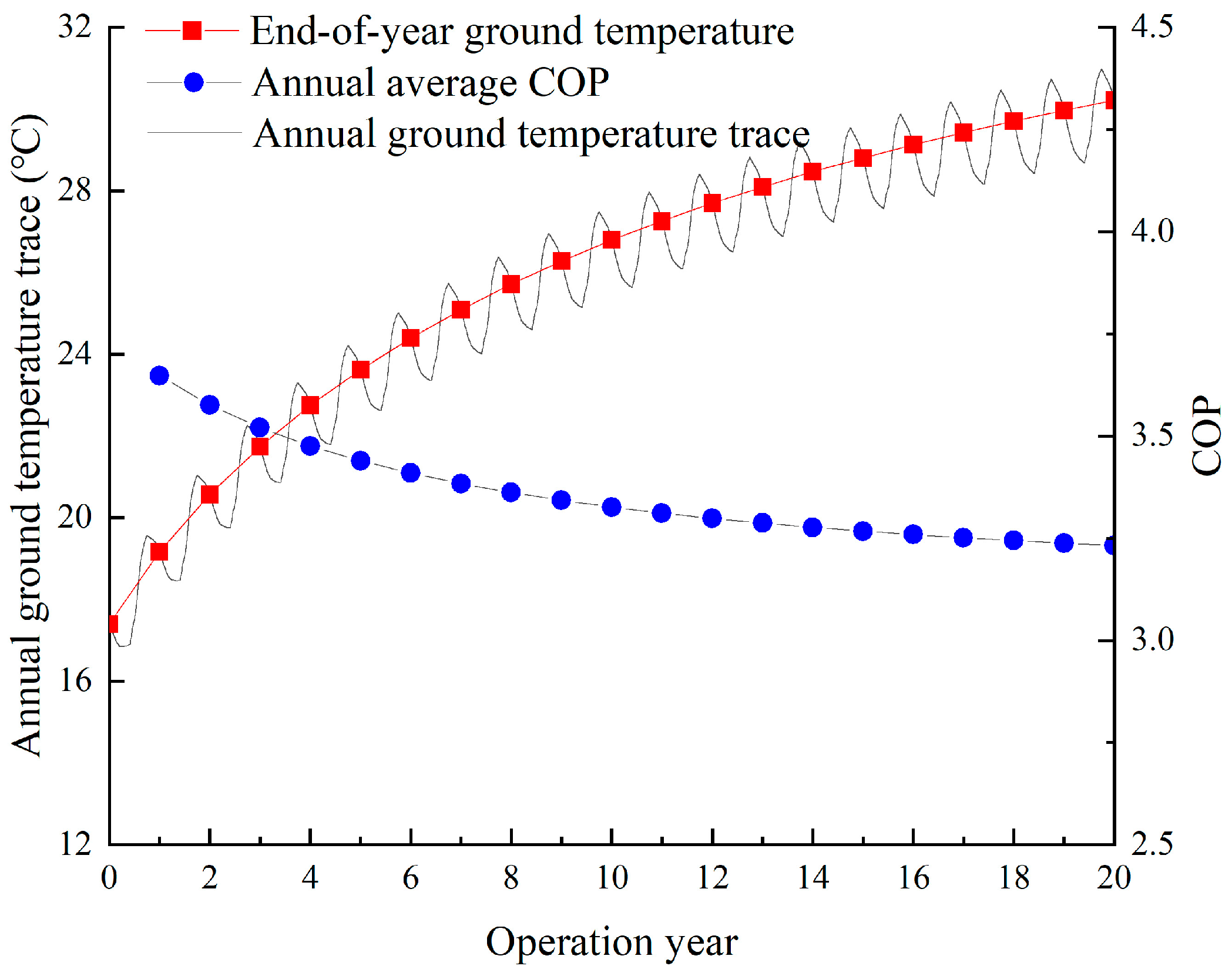
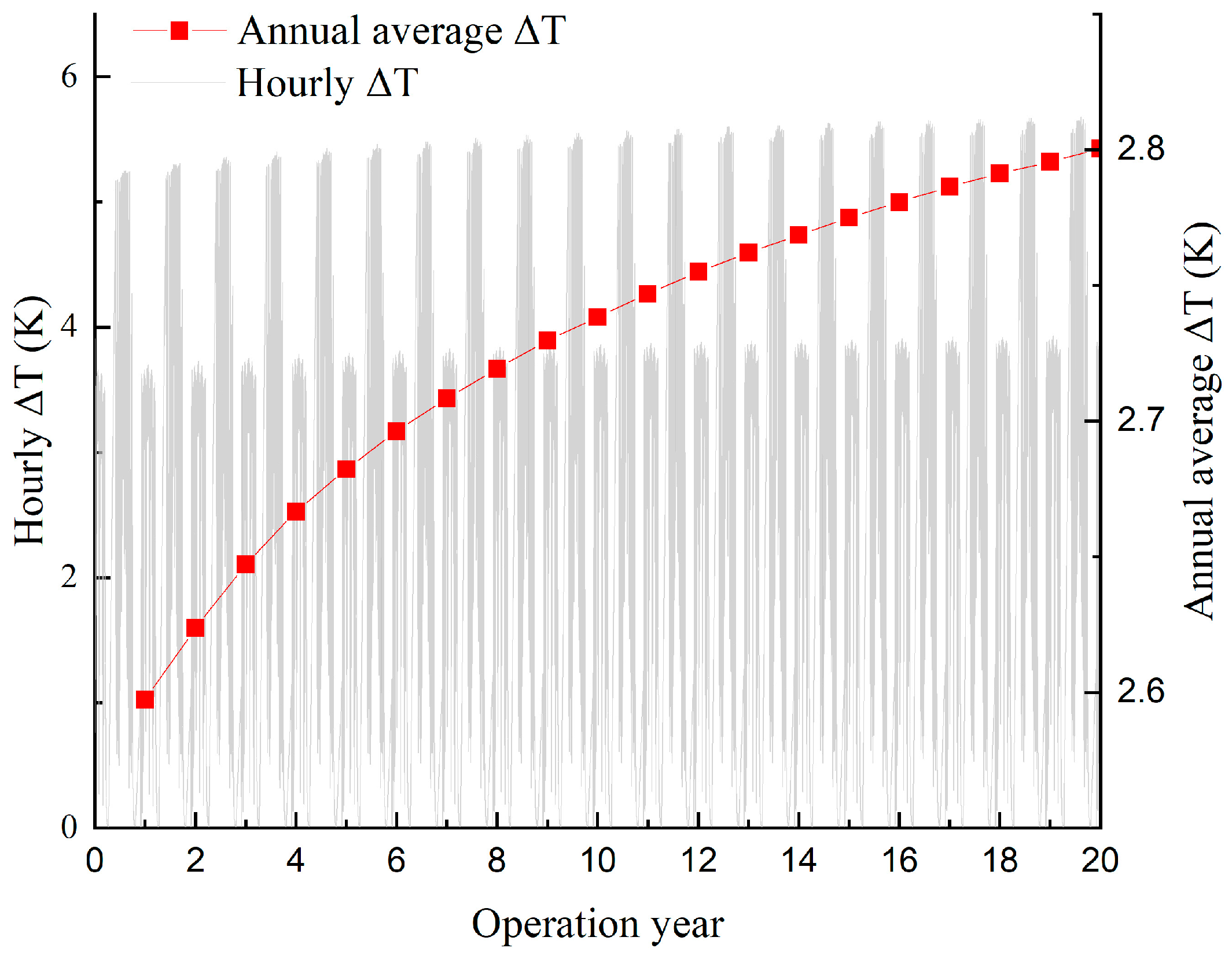

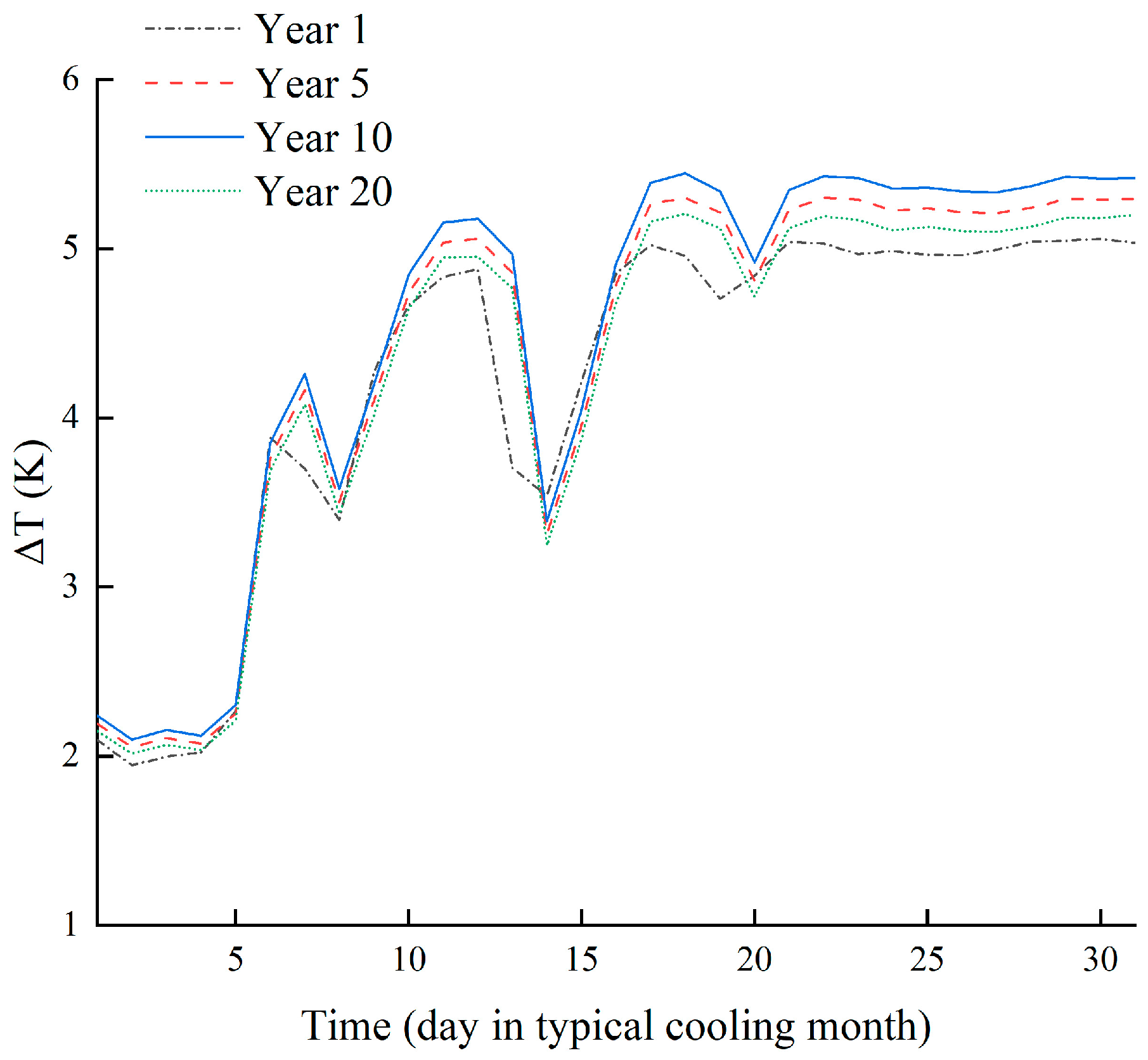
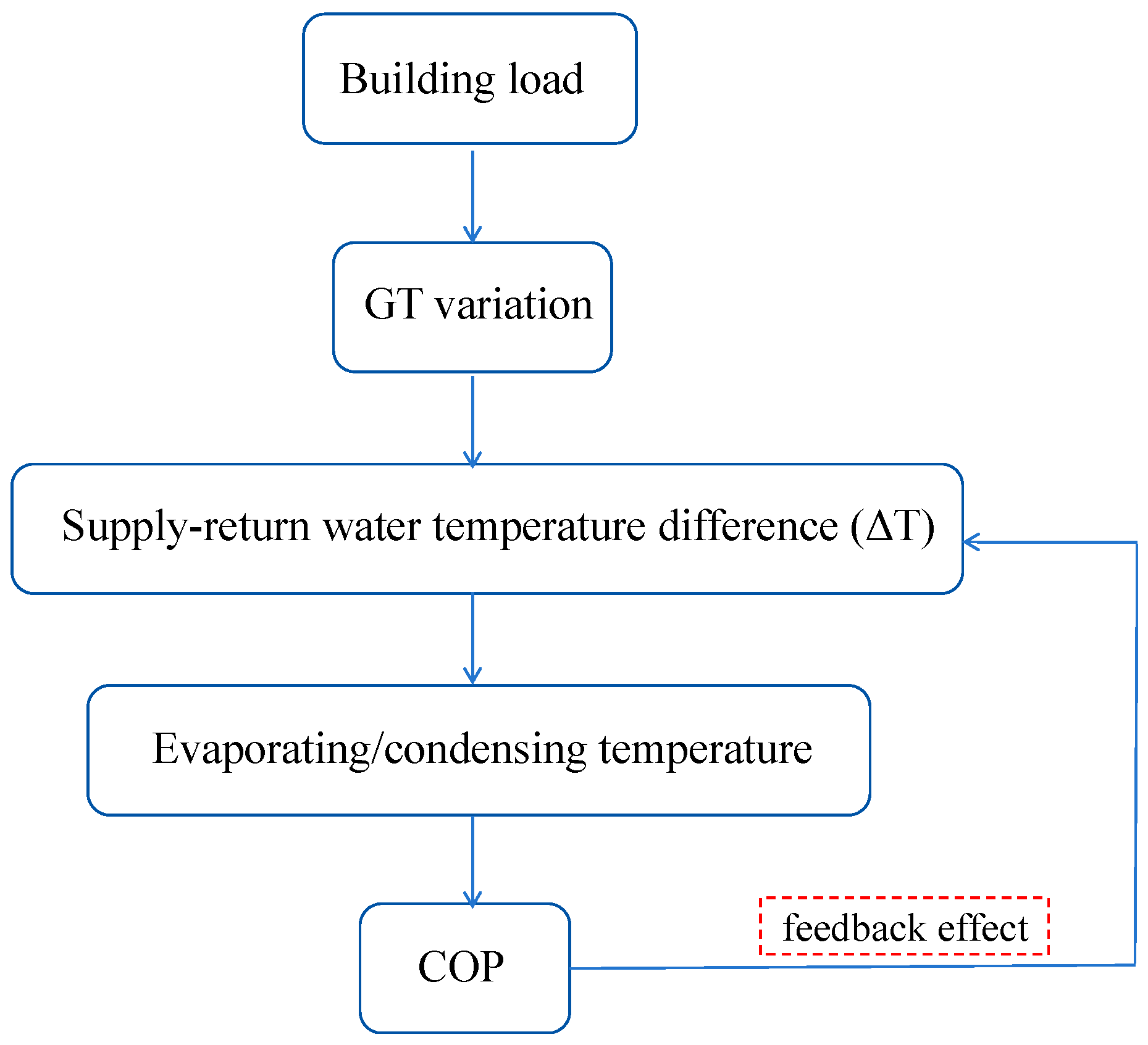
| Parameter | Value | Unit |
|---|---|---|
| Summer indoor temperature | 26 | °C |
| Summer indoor humidity | 40 | % |
| Winter indoor temperature | 20 | °C |
| Winter indoor humidity | - 1 | % |
| Occupant density | 0.125 | person/m2 |
| Fresh air supply per person | 30 | m3/(h·person) |
| Equipment power density | 15 | W/m2 |
| Lighting power density | 9 | W/m2 |
| Parameter | Value | Unit |
|---|---|---|
| Number of boreholes | 90 | - |
| Borehole depth | 100 | m |
| Borehole diameter | 120 | mm |
| Borehole spacing | 6 | m |
| Pipe inner/outer diameter | 26/32 | mm |
| Pipe thermal conductivity | 0.44 | W/m2 |
| Grout thermal conductivity | 2.1 | W/m2 |
| Soil thermal conductivity | 2.6 | W/m2 |
| Soil volumetric heat capacity | 3100 | kJ/(m3·K) |
Disclaimer/Publisher’s Note: The statements, opinions and data contained in all publications are solely those of the individual author(s) and contributor(s) and not of MDPI and/or the editor(s). MDPI and/or the editor(s) disclaim responsibility for any injury to people or property resulting from any ideas, methods, instructions or products referred to in the content. |
© 2025 by the authors. Licensee MDPI, Basel, Switzerland. This article is an open access article distributed under the terms and conditions of the Creative Commons Attribution (CC BY) license (https://creativecommons.org/licenses/by/4.0/).
Share and Cite
Huang, Y.; Zhao, Z.; Sun, M. Performance Degradation of Ground Source Heat Pump Systems Under Ground Temperature Disturbance: A TRNSYS-Based Simulation Study. Energies 2025, 18, 3909. https://doi.org/10.3390/en18153909
Huang Y, Zhao Z, Sun M. Performance Degradation of Ground Source Heat Pump Systems Under Ground Temperature Disturbance: A TRNSYS-Based Simulation Study. Energies. 2025; 18(15):3909. https://doi.org/10.3390/en18153909
Chicago/Turabian StyleHuang, Yeqi, Zhongchao Zhao, and Mengke Sun. 2025. "Performance Degradation of Ground Source Heat Pump Systems Under Ground Temperature Disturbance: A TRNSYS-Based Simulation Study" Energies 18, no. 15: 3909. https://doi.org/10.3390/en18153909
APA StyleHuang, Y., Zhao, Z., & Sun, M. (2025). Performance Degradation of Ground Source Heat Pump Systems Under Ground Temperature Disturbance: A TRNSYS-Based Simulation Study. Energies, 18(15), 3909. https://doi.org/10.3390/en18153909





